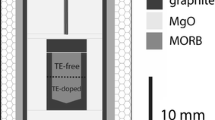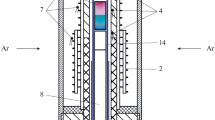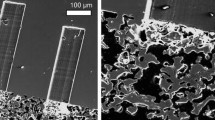Abstract
The diffusion properties of Na, Cs, Ba, Fe and Eu ions have been determined experimentally for a pantellerite melt and of these ions plus Li, Mn and Co in pitchstone melt, using the radiotracer residual-activity method, and narrow platinum capillaries, over the temperature range 1,200–1,400° C. In addition, Eu diffusion in a basaltic and an andesitic melt was determined. Diffusion of all cations follows an Arrhenius relationship, activation energy values being high for diffusion in the pantellerite melt (e.g. Eu: 100 kcal mol−1) except in the case of Na (24.3 kcal mol−1). Activation energies of diffusion in the pitchstone melt are similar to values recorded earlier for andesitic and basaltic melts.
The new data are used, along with previously published data for diffusion in other composition melts, to examine the compositional and structural controls on diffusion. The range of diffusivities shows a marked change with melt composition; over two orders of magnitude for a basaltic melt, and nearly four orders for a pantellerite melt (both at 1,300° C). Diffusivity of all cations (except Li and Na) correlates positively with the proportion of network modifying cations. In the case of Li and Na the correlation is negative but the diffusivity of these ions correlates positively with the proportion of Na or of Na + K ions in the bulk melt. Diffusion behaviour in the pantellerite melt departs from the relationships shown by the data for other melt compositions, which could be partly explained by trivalent ions (such as Fe) occupying network forming positions. The diffusivity of alkali metal ions is strongly dependent on ionic radius, but this is not the case with the divalent and trivalent ions; diffusivity of these ions remains relatively constant with change in radius but decreases with increase in ionic charge.
A compensation diagram shows four distinct but parallel trends for the majority of the cations in four melt types but the data for Li and Na plot on a separate trend. This and the other relationships are used to elucidate possible mechanisms of diffusion. Exchange mechanisms appear to be common, with the preservation of local charge balance. Li and Na diffuse by a distinct mechanism which involves exchange of similar or identical ions. The diffusion behaviour of the smaller alkali metal ions is sufficiently distinct from all other cations to indicate that diffusion could be an important factor in the geochemical fractionation of the alkali elements.s
Similar content being viewed by others
References
Binsted N, Greaves GN, Henderson CMB (1984) The atomic environment of iron in silicate glasses. Progr Expt Petrol (Natural Environment Research Council Publ Ser D) Sixth Rept 57–63
Cunningham GJ, Henderson P, Lowry RK, Nolan J, Reed SJB, Long JVP (1983) Lithium diffusion in silicate melts. Earth Planet Sci Let 65:203–205
Dowty E (1980) Crystal-chemical factors affecting the mobility of ions in minerals. Am Mineral 65:174–182
Dunn T (1982) Oxygen diffusion in three silicate melts along the join diopside-anorthite. Geochim Cosmochim Acta 46:2293–2299
Hofmann AW (1980) Diffusion in natural silicate melts: a critical review. In Hargraves RB (ed) Physics of magmatic processes. Princeton Univ Press, New Jersey, pp 385–417
Hofmann AW, Brown L (1976) Diffusion measurements using fast deuterons for in situ production of radioactive tracers. Carnegi Inst Yearb 75:259–262
Hofmann AW, Magaritz M (1977) Diffusion of Ca Sr Ba and Co in a basalt melt: implications for the geochemistry of the mantle. J Geophys Res 82:5432–5440
Jambon A (1982) Tracer diffusion in granitic melts: experimental results for Na, K, Rb, Cs, Ca, Sr, Ba, Ce, Eu to 1,300° C and a model of calculation. J Geophys Res B87:10,797–10,810
Jambon A, Carron J-P, Delbove F (1978) Données préliminaires sur la diffusion dans les magmas hydrates: le cesium dans un liquide granitique à 3 kbar. Comptes rendus Acad Sci Paris 287 Ser D: 403–406
Lowry RK, Reed SJB, Nolan J, Henderson P, Long JVP (1981) Lithium tracer-diffusion in an alkali-basaltic melt — an ion-microprobe determination. Earth Planet Sci Lett 53:36–40
Lowry RK, Henderson P, Nolan J (1982) Tracer diffusion of some alkali, alkaline-earth and transition element ions in a basaltic and an andesitic melt, and the implications concerning melt structure. Contrib Mineral Petrol 80:254–261
Magaritz M, Hofmann AW (1978a) Diffusion of Sr, Ba and Na in obsidian. Geochim Cosmochim Acta 42:595–605
Magaritz M, Hofmann AW (1978b) Diffusion of Eu and Gd in basalt and obsidian. Geochim Cosmochim Acta 42:847–858
Mysen BO, Virgo D, Kushiro I (1981) The structural role of aluminium in silicate melts — a Raman spectroscopic study at 1 atmosphere. Am Mineral 66:678–701
Mysen BO, Virgo D, Seifert FA (1982) The structure of silicate melts: implications for chemical and physical properties of natural magmas. Rev Geophys Space Phys 20:353–383
Nelson C, White WB (1980) Transition metal ions in silicate melts 1. Manganese in sodium silicate melts. Geochim Cosmochim Acta 44:887–893
Nelson C, Furukawa T, White WB (1983) Transition metal ions in glasses: network modifiers or quasi-molecular complexes. Mat Res Bull 18:959–966
Seifert F, Mysen BO, Virgo D (1982) Three dimensional network structure of quenched melts (glass) in the systems SiO2-NaAlO2, SiO2-CaAl2O4 and SiO2-MgAl2O4. Am Mineral 67:696–717
Shannon RD (1976) Revised effective ionic radii and systematic studies of interatomic distances in halides and chalcogenides. Acta Cryst A32:751–767
Winchell P (1969) The compensation law for diffusion in silicates. High Temp Sci 1:200–215
Whittaker EJW (1978) The cavities in a random close-packed structure. J Non-Cryst Solids 28:293–304
Author information
Authors and Affiliations
Rights and permissions
About this article
Cite this article
Henderson, P., Nolan, J., Cunningham, G.C. et al. Structural controls and mechanisms of diffusion in natural silicate melts. Contr. Mineral. and Petrol. 89, 263–272 (1985). https://doi.org/10.1007/BF00379459
Received:
Accepted:
Issue Date:
DOI: https://doi.org/10.1007/BF00379459




